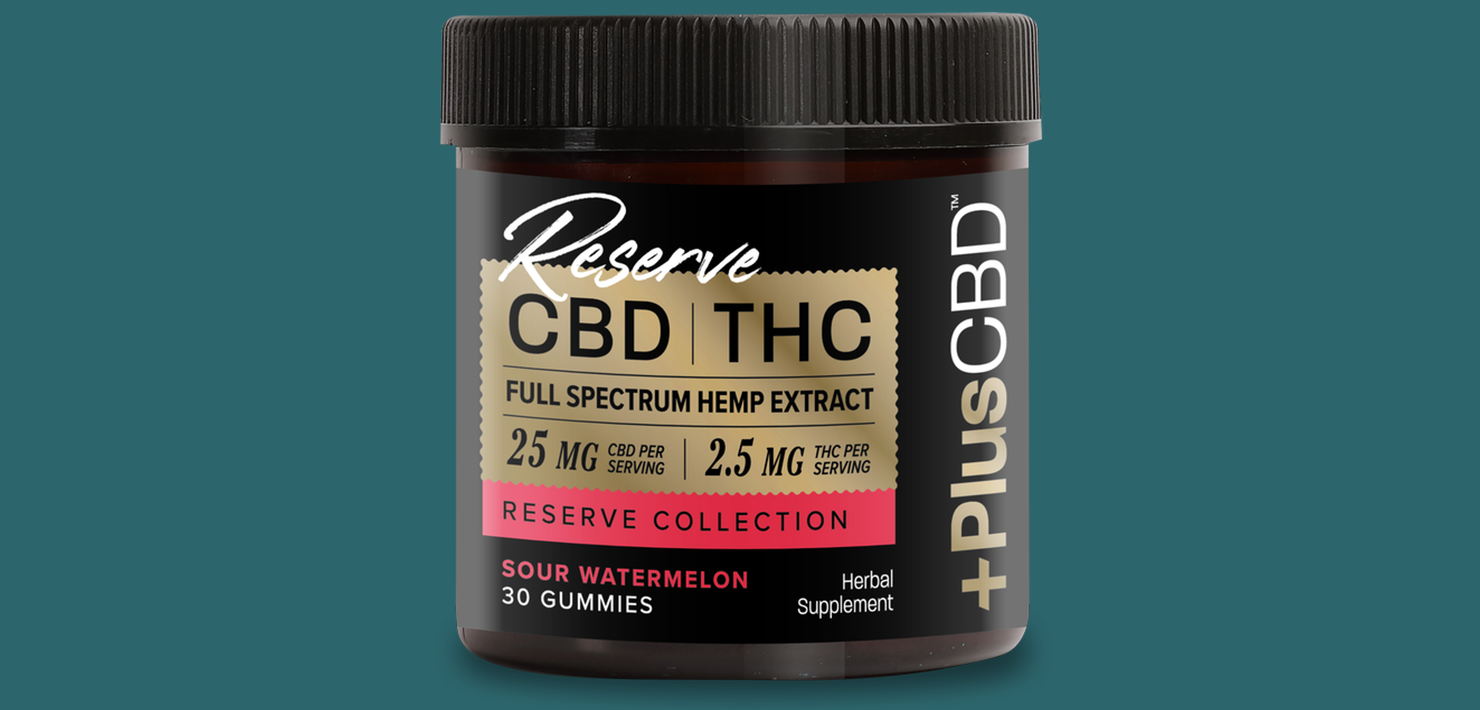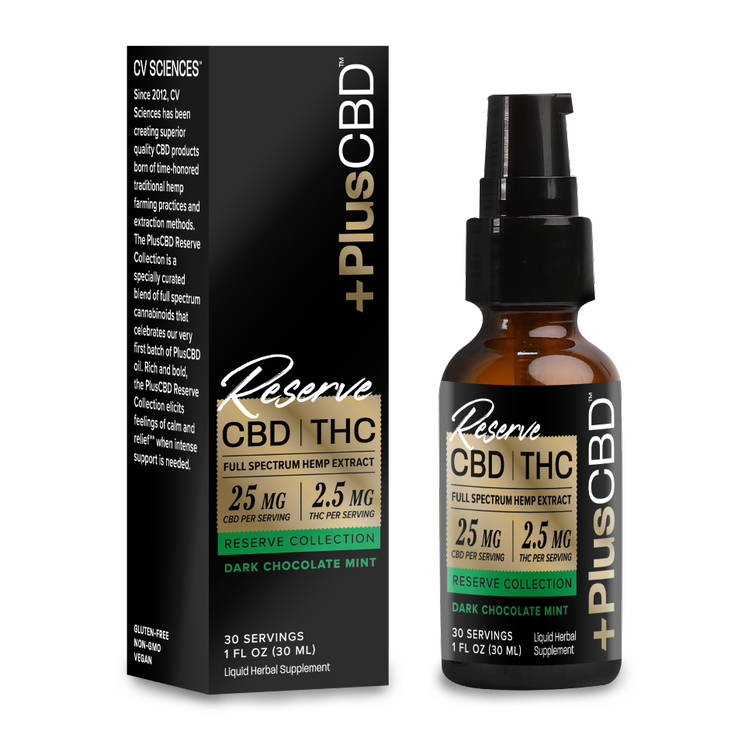Welcome!
ARE YOU OVER 21 YEARS OF AGE?
Oct 4, 2021


In PlusCBD’s Reserve Collection, through a combination of distillation and blending techniques, we apply years of cannabinoid formulation expertise to deliver the perfect amount of hemp-derived THC, as part of an herbal dietary supplement. In liquid tinctures and gummies, full-spectrum hemp containing both CBD and THC works to support the endocannabinoid system. PlusCBD Reserve Collection products contain either 10:1 or 20:1 CBD to THC ratios, with levels below 0.3%. Thus, a new Reserve gummy would have as much as 2.5 mg of hemp-derived THC per serving.
Why 2.5 mg of THC? Aside from being consistent with the limit of the Farm Bill, it has also been determined to be a safe threshold for THC consumption by European health regulatory agencies and trade groups(1). As this is a dietary supplement containing hemp-derived THC at a low level, one would expect the sensation of consuming it to be different than a cannabis product found in medicinal or recreational dispensaries, often containing at least 5 mg of THC. Indeed, the intention behind the formulation of The Reserve Collection isn’t to get one high! This is a wellness product that broadens the toolchest of cannabinoid ingredients to promote and support good health. CV Sciences does caution, however, that sensitive individuals start low and go slow to find their perfect serving size.
A brief note on the legality of our The Reserve Collection: the way that the law is currently written permits the presence of detectable levels of THC, so long as the extracts contain no more than 0.3% dry weight THC. Although regulations are constantly changing, the current interpretation of the law permits us to introduce a new line of craft batch hemp extracts… with more, lawful, hemp-derived THC, to help you find your golden hour.
For the better part of a decade, CV Sciences has been making PlusCBD Oil from the seed, stalk, and stem of agricultural hemp. The distilled oil from this plant material holds the appearance of liquid gold – and is teeming with fatty acids, terpenoids, vitamins, and cannabinoids. The hemp plant is thought to contain more than 500 different chemical constituents including cannabinoids. Cannabinoids are a wide family of compounds with various effects on the body when ingested. Cannabidiol (CBD), is the major cannabinoid found in food and fiber agricultural hemp, and is found together with trace levels of THC in a full-spectrum hemp extract.
In contrast, many producers of hemp extracts market CBD isolates. An isolate is a highly purified extract, containing basically just the CBD and not much else of that rich hemp chemistry. Although some consumers prefer CBD isolates because they are concerned about the trace levels of THC for ethical or occupational reasons, emergent evidence suggests that a full-spectrum extract is desirable for wellness due to a phenomenon referred to as the entourage effect.
The concept of botanical synergy is no stranger in herbal medicine. Just as the herb turmeric is more than its curcumin content, hemp is more than CBD or THC. The symphony of 500 constituents in a full-spectrum hemp extract has shown to affect the body differently than isolated CBD or THC alone. For example, some of the scent compounds in hemp, the terpenes, are shown to promote relaxation and may complement the activity of the CBD. Biochemical interactions of different cannabinoids at the cannabinoid receptors (more on this later) may promote improvements in comfort and wellness that isn’t seen with isolated compounds at the same doses. This concept applies to pairing CBD with trace, lawful amounts of hemp-derived THC. The two work together, as a group, in entourage.
The endocannabinoid system (ECS) is a transmitter system found throughout the body, comprised of cannabinoid receptors (CBs) and dietary fat-derived ligands that bind to them. Cannabinoid receptors are highly expressed throughout the brain, and within immune cells, liver, gut, skin, etc., where they mediate a range of effects including food-seeking behavior, sleep cycles, pain signaling and emotions. Dysregulation of the ECS may be in association with certain pathological states, and scientists are exploring the use of cannabis to restore the system to balance (2).
Modulation of the ECS with ingredients such as CBD can help the body to be more comfortable and get better rest. However, some individuals may require a stronger effect on the system. Whereas CBD does not directly bind to the CB1 receptor, the THC from cannabis does. Excess amounts of THC cause euphoria (a high) that is mediated by the CB1 receptor. Some studies indicate that CBD can counteract the excess effects of THC consumption, which is why some cannabis practitioners suggest taking THC and CBD together (3).
Additionally, scientists are exploring a role for low-dose THC consumption in health and wellness (4). At levels below a dose that would get one high, THC has been shown to support cognitive and neurological health, as well as pain and comfort levels. Although the research is in its infancy, it points to the responsible use of THC as part of a wellness supplement regimen.
CV Sciences planted the first legal hemp seed in 2014, the first seed since the passage of the Controlled Substances Act. The bipartisan Farm Bill passed in 2014, enabling researchers to grow hemp defined as Cannabis sativa L., containing no more than 0.3% THC, or tetrahydrocannabinol, the major illicit constituent in cannabis. When CV Sciences planted the seed at Murray State University in Kentucky to support their research into agricultural hemp, it was understood that this was just the beginning. In 2018, the Farm Bill liberated hemp from the Controlled Substances Act for commercial use.
The forward flow of history is an inevitability, and with CBD and hemp-extracts, there has been no other ingredient that has gone from illicit and controlled, to mom and pop on Main Street. With this spirit, now is the best time to explore the full treasure trove of cannabinoids and constituents from hemp, including lawful amounts of THC. Trust CV Sciences, with nearly a decade of hemp-formulation experience, hemp activism, and promotion of cannabis science, and research to deliver on The Reserve Collection as a go to source for a rich, deep and truly full-spectrum hemp experience.
References
1) EFSA CONTAM Panel (EFSA Panel on Contaminants in the Food Chain), 2015. Scientific Opinion on the risks for human health related to the presence of tetrahydrocannabinol (THC) in milk and other food of animal origin. EFSA Journal 2015;13(6):4141, 125 pp. doi:10.2903/j.efsa.2015.4141
2) Russo EB. Clinical Endocannabinoid Deficiency Reconsidered: Current Research Supports the Theory in Migraine, Fibromyalgia, Irritable Bowel, and Other Treatment-Resistant Syndromes. Cannabis Cannabinoid Res. 2016 Jul 1;1(1):154-165. doi: 10.1089/can.2016.0009. PMID: 28861491; PMCID: PMC5576607.
3) Boggs DL, Nguyen JD, Morgenson D, Taffe MA, Ranganathan M. Clinical and Preclinical Evidence for Functional Interactions of Cannabidiol and Δ9-Tetrahydrocannabinol. Neuropsychopharmacology. 2018 Jan;43(1):142-154. doi: 10.1038/npp.2017.209. Epub 2017 Sep 6. PMID: 28875990; PMCID: PMC5719112.
4) Calabrese EJ, Rubio-Casillas A. Biphasic effects of THC in memory and cognition. Eur J Clin Invest. 2018 May;48(5):e12920. doi: 10.1111/eci.12920. Epub 2018 Apr 2. PMID: 29574698.